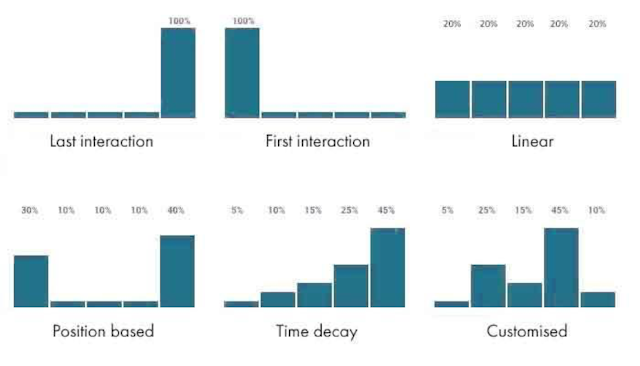Which marketing attribution model is right for your business?
Your marketing data tells a completely different picture depending on which angle you examine it from. Your latest content marketing initiative may look bleak if you look at it in the vacuum: it may not bring direct sales. But if you move one step ahead or back, you might notice that it has actually contributed indirectly to conversions. Customers came to your blog from organic search and later converted via email.

Vertical Leap simplify various marketing attribution models so marketers which would be most suitable for their business.
Attribution modelling allows you to determine what’s working and what’s not by flipping your data in one way or another.
Attribution Models: Quick Definition
An attribution model is a set of algorithmic rules used by analytics platforms (such as Google Analytics) to determine which marketing actions generated sales/conversions at different stages of the buyer's journey. It can help you identify the role of different channels (organic/paid search, social media, affiliates etc) in the sales process and assign a percentage score to each of those touchpoints. In short, they provide a better idea of the ROI each marketing channel generates.
The six standard attribution models

Last Interaction attribution (also "last-click") is the default option offered by Google Analytics. It gives 100% of the credit to the last touchpoint a customer had with your business but does not account for any previous interactions. However, it provides no visibility into assisted conversions, making it an unreliable choice for analysing complex sales funnels. Also, this model can eschew your perception towards thinking that only one (or few) of your marketing initiatives work, even if that’s not the case.
First Interaction attribution (also "first click) does the opposite to the previous model: it gives 100% of the credit to the first interaction. This model is a good way to measure demand generation and pit several acquisition channels against one another to determine the best one. But the model is short-sighted when it comes to omnichannel digital marketing campaigns and of little use to businesses with long sales cycles.
Linear attribution. The bounty for the conversion is split equally between all touchpoints. Each marketing channel receives equal credit for each conversion (e.g. 50%-50%). Linear attribution is a good first step towards practising multi-touch attribution analysis. Unlike previous models, this one actually allows you to tweak different campaigns/channels to get better results. But it fails to tell which activity brings the best ROI and where you should place more budgets.
Position based attribution assigns 40% of the credit to first and last touchpoints and splits the remaining allocation between the other encounters a customer had with your brand. This way you can do more CRO for the two main channels, as well as gain visibility into the interim touchpoints. But the emphasis on the first/last channel may not realistically represent your business cycles. For instance, a prospect could have landed to your website via a random social media link, but later reactivated with a personalised email offer or a webinar. Without those nudges, she wouldn’t be “sold”.
Time decay attribution model distributes the credit between different channels based on when the customer has interacted with your brand. Interactions taking place closer to the time of purchase are valued higher, whereas the first interaction is considered the least important one. Usually, this model is a top choice for businesses with long sales cycles, as it allows to optimise interactions with bottom of the funnel customers. Assisted conversions receive a fairer representation as well. But this model diminishes the importance of brand awareness campaigns. Plus, it neglects the role of more important touchpoints (e.g. email marketing) that could have assisted with conversions earlier in the funnel.
Custom attribution modelling. Each of these five models can be upgraded with additional rules to match your business needs. Also, you can benchmark them against one another using the Google Model Comparison Tool. By reconciling analytics data you can distil additional insights and improve visibility into customer journeys to some extent. But you cannot completely change the credit allocations suggested by different types of models.
The alternative: data-driven attribution modelling
Instead of using the standard models, your company can opt to develop a data-driven attribution model.
Custom algorithms can be deployed to analyse different conversions paths derived from your GA data and identify important touchpoints customers have had with your brand in different marketing sequences. This type of model is constantly evolving and represents what happens under the hood of all your marketing campaigns with higher accuracy.
You can obtain real-time insights into how different channels are performing, what creative assets play the most important roles and which campaigns are bringing in steady ROI. Such models can be further enhanced with predictive analytics. In this case, algorithms will be able to estimate the performance of certain campaigns; pinpoint where optimisation should be applied and suggest when to double up or pipe down spending on a certain campaign.
Data-driven attribution modelling delivers a personalised view into your business, and gives the most accurate credit weights to different touchpoints in the entire customer journey.
George Karapalidis is a data scientist at Vertical Leap.
Content by The Drum Network member:

Vertical Leap
We are an evidence-led search marketing agency that helps brands get found online, drive qualified traffic to their websites and increase conversions/sales.
To...

